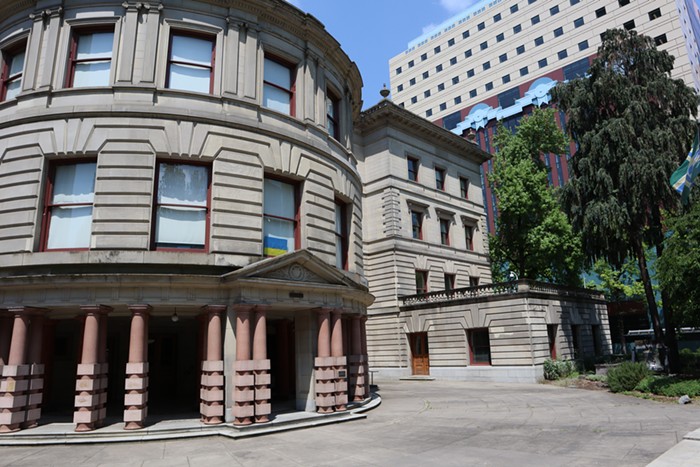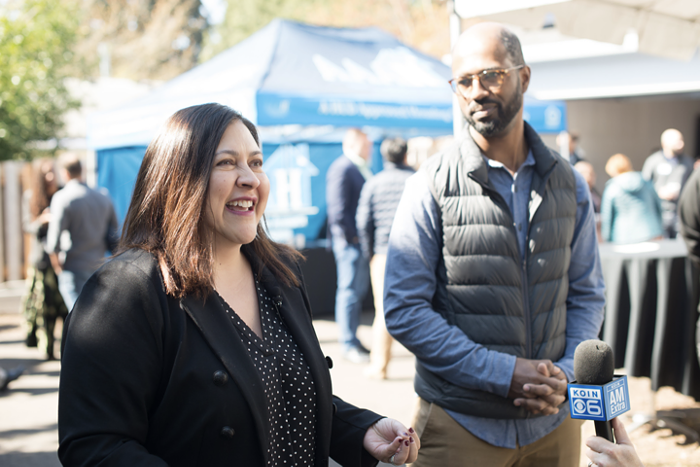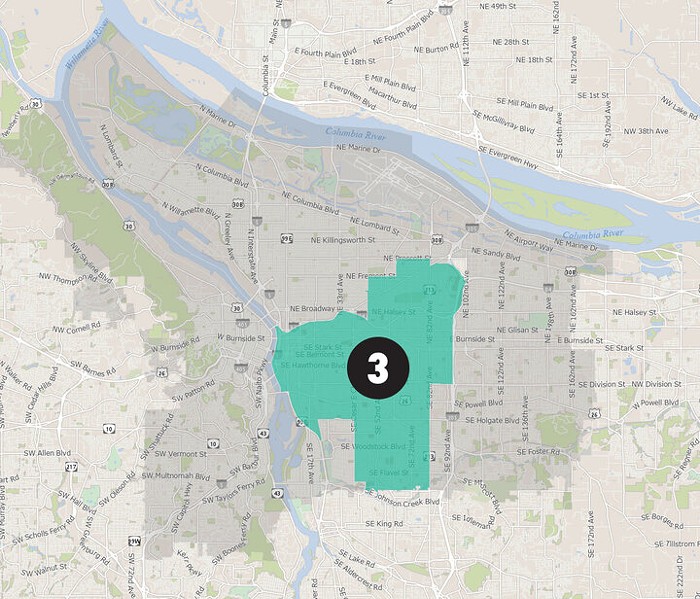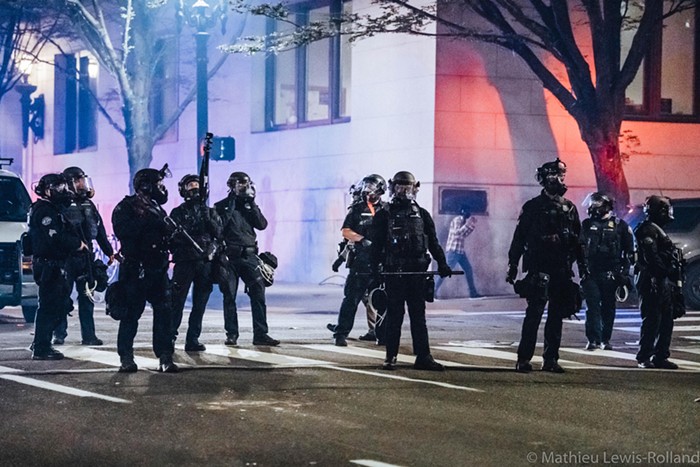
Governor Kate Brown endorsed a freeway cover design for the Interstate-5 Rose Quarter expansion project Tuesday, moving the years-long battle over freeway caps one step closer to a final design.
While the Oregon Department of Transportation's (ODOT) Rose Quarter Improvement Project was initiated in 2012 to address the rush hour bottleneck on the freeway, the project has grown to include restorative justice elements for the Albina neighborhood—the historically Black neighborhood that was partially demolished and bisected by the original construction of the I-5 corridor in the late 1950s. The inclusion of freeway caps—steel and concrete platforms that reconnect the streetscape over the top of the freeway corridor—emerged as one of the leading solutions for returning some of the neighborhood land back to the community for redevelopment. While advocates for revitalizing Albina and Portland’s regional leaders endorsed the inclusion of freeway covers that could support the weight of full city blocks on top of the freeway, ODOT was resistant to adding robust covers to the project design due to the additional cost and the possible delays the change in project design would cause.
Tension over the inclusion and integrity of the cover has been mounting between regional leaders and ODOT for the past couple of years, with the issue often being cited as a roadblock towards moving forward on the project. That’s when Brown stepped in and started holding meetings with various advocacy groups, Portland leaders, and the state transportation department. Using the input from those meetings, Brown decided which of six possible cover designs proposed by an independent design company hired by ODOT to endorse for the project, effectively giving the project the kick in the pants it needs to move forward.
Brown endorsed a cover design that reconnects part of the project area’s surrounding street grid during a joint meeting with various ODOT committees assigned to guide the I-5 project. The design, called “Hybrid 3,” features a single cover over the freeway stretching from NE Wielder St. to just south of NE Tillamook St. The cover offers 4.1 acres of land that could be integrated into the historic Albina neighborhood.

The design would add an estimated 10 to 12 months to the project timeline, but would not delay the planned 2023 construction start date. When discussing potential cover designs earlier this year, contractors like Raimore Construction—a Black-owned construction company hired as a subcontractor for the project—expressed concern that the design changes would delay the project and cause them to lose out on the contract. This cover design avoids that issue.
“Hybrid 3 option addresses safety, congestion, and environmental concerns of the original project, while also, and most importantly, providing a canvas for development opportunities that the community members seek, along with a project timeline that can leave existing contract opportunities in place,” Brown said during the meeting. City and county officials also supported the Hybrid 3 design in meetings with the Governor before she made a final recommendation.
Advocates for investments in the historic Albina neighborhood are considering Brown’s endorsement of the cover model a win.
Albina Vision Trust (AVT)—an organization advocating for the revitalization of the neighborhood—lauded Brown for her endorsement, writing in a press release that her intervention “snatched victory out of the jaws of defeat.”
“Now we can move forward with a project that will provide good jobs, create community wealth building opportunities and repair the urban fabric in the heart of the city,” said AVT Director Winta Yohannes.
While Brown’s endorsement holds significant weight, the final cover design is still to be determined. The project’s Executive Steering Committee will make its cover recommendation to the Oregon Transportation Commission (OTC)—ODOT’s governing body—by the end of August. The OTC will consider the committee and Brown’s recommendations and make the final decision on what cover design the project will move forward with in the fall. Given the consensus from state, county, and city leaders on the Hybrid 3 design, it would be surprising if the OTC chose a different design, but not out of the realm of possibility.
According to the Rose Quarter Improvement Project Director Megan Channell, the Hybrid 3 design’s analysis is still in its early stages. Part of that design analysis will be determining what type of buildings the covers will be able to support.
The current cover concepts would support two or three-story buildings, but Channell said ODOT is exploring how to make the covers support up to five-story buildings. The Executive Steering Committee—which includes representatives from TriMet, trucking organizations, Portland Public Schools, and other community groups—has also provided input on what type of buildings the covers should be able to support. ODOT will spend the rest of the year fine-tuning the selected cover design.
As the OTC moves closer to making a decision on the cover design, the conversation around the project can return towards other issues—for example, how the state will actually pay for I-5 expansion.
Starting in 2022, the Oregon Legislature is slated to set aside $30 million per year for the project, but that is a drop in the bucket next to the project’s nearly $800 million price tag—a figure that doesn’t include the cost of the freeway covers, which will push the project over the $1 billion threshold. Brown has also urged that the project includes congestion pricing—a mechanism to charge drivers for using roads during the busiest times as a way to reduce demand—which could help fund the construction, but studies on the efficacy of congestion pricing in the area are still unfinished.
In June, members of Oregon’s federal delegation—state representatives Ron Wyden and Jeff Merkley and Congressman Earl Blumenauer—sent a letter to Brown promising to fight for federal dollars for the I-5 project as long as the highway cover was included in the design. The final approval of the Hybrid 3 design from the OTC would clear the way for Oregon’s federal representatives to secure money from the federal government, most likely through the Reconnecting Communities Act—a program that aims to fund the reconstruction of street grids in divided communities, like Albina, that would be created through the historic $1 trillion infrastructure bill.
For AVT, Brown’s cover design endorsement allows their advocacy to move beyond pushing for the inclusion of a cover and start focusing on what is actually built atop the highway cover. ODOT owns the land on top of the cover by default, but Channell said the department is reviewing best practices across the country to determine how to best put the land back under the community’s control. That may include 99-year leases, selling the land to the community at below-market price, or land easements.
Once the cover design is finalized, determining what kinds of buildings go where on the covers will be an intergovernmental and community conversation. While ODOT will determine how the cover land is leased or transferred to the community, the City of Portland is responsible for issuing the necessary permits for buildings on top of the covers. The streets that cross over the cover are owned by PBOT, so the transportation agency will need to return to project discussions with ODOT—something that PBOT Commissioner Jo Ann Hardesty said she would only do if a plan was developed for moving Harriet Tubman Middle School, which has suffered poor air quality due to its location right next to the freeway.
Brown has also shown strong support for relocating of the school, and Brown’s Equity and Racial Justice Director Shannon Singleton said that the Governor’s office is currently investigating how to finance the move. Harriet Tubman serves a historically Black student population and many regional leaders and community stakeholders have pointed to moving the school as a way for ODOT to not only start repairing previous harm done by the construction of the freeway corridor, but mitigate the ongoing harm of exposing schools children to constant vehicle pollution.
Singleton also noted during the meeting that, while Brown is adamant that restorative justice values be included in the Rose Quarter project, integrating racial equity values within a bureaucratic process is still new territory for the state.
“I think the state has been really honest that everybody is learning what it actually means to operationalize racial equity,” Singleton said. “We can say those words, but how to do it and do it on the ground, people are still figuring out. I don't think anyone has quite got it. So, please keep giving us feedback.”



















